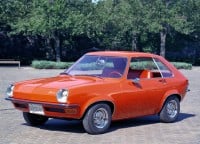Volt Birth Watch 97: GM's 1969 Plug In Hybrid

Bob Lutz might try to have us believe that he “invented” the plug-in hybrid Volt. In reality, he just dusted off old plans on GM’s shelves for their 1969 XP-883. Forty years ago, in response to concerns about tightening emission standards and future oil supplies, GM unveiled a plug-in hybrid city car concept. Six 12 Volt lead-acid batteries propelled the Smart-sized car electrically up to about ten mph, when a tiny 600cc two-cylinder gas engine kicked in to provide additional motivation up to its maximum top speed of sixty. The XP-883 seated two adults, plus two kiddies facing backwards, perched above the battery pack. The cute-as-a-button fiberglass bodied coupe foreshadowed both Vega and Opel 1900/Ascona styling. If GM had made it, it would undoubtedly have gotten you laid (with hairy-legged girls) just like the Volt will in 2010. But then what wouldn’t, in 1969? Maybe that’s why they didn’t bother.

More by Paul Niedermeyer


































Comments
Join the conversation
Didn't Alan Cocconi, the controller designer, quit the EV1 project because he wanted to make it hybrid and market practical? Folks at http://ev1.org seem to feel that GM has been sandbagging with electric cars because they are deeply dependant on oil revenue coupled with after market service revenue and Electric vehicles are almost service-free. Then there is the issue of who would pay and be responsible for post-use battery recycling and disposal…One thing I never got….That 1969 plug in was a tiny car for the time. Why didn’t the General use the full size car platform since it could carry more batteries and electric motors have tons of torque to motivate a big car?
Wow! Those cars used Ag-Zn batteries... People talk about NiMH and Li-ion having short lifetimes at a thousand cycles. Ag-Zn batteries last on the order of tens of cycles. As in, if you get 25 cycles you're doing really good. I'm sure they chose them for their decent energy density (~100-125 Wh/kg) for proof of concept. For comparison, a really good lead acid is ~35 Wh/kg. Top end solar powered race cars used Ag-Zn in the World Solar Challenge up until 1999 when Li-ion started showing up in a few cars. In the 2001 race almost no one was running Ag-Zn because you could do so much better with Li-ion. Of course, our cycle counts were